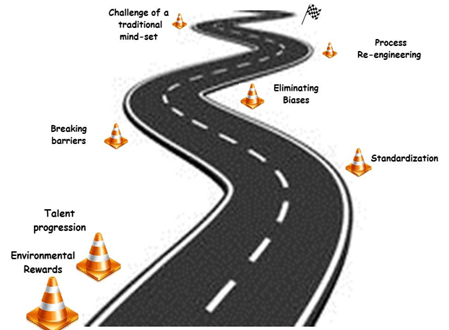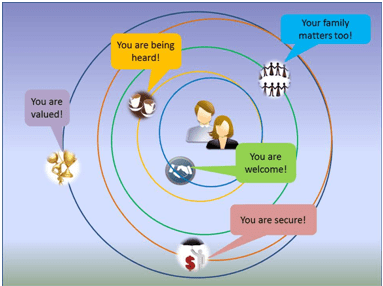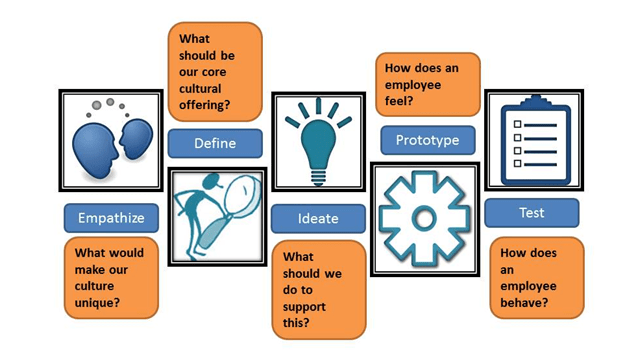Can Design Thinking principles be applied in Human Resource Management? This is a question that comes around quite often, albeit masked with apprehensions. A quick deep dive into the history of design thinking would help in demystifying this myth that Design Thinking is for products alone.
Computer scientist and Nobel Prize laureate Herbert A. Simon was the first to mention design as a science or way of thinking in his 1969 book, Sciences of the Artificial. From the 1970s, Design Thinking steadily evolved in the design community before entering the mainstream in the 2000s.
Design thinking’s tools and methods borrow from a variety of disciplines, including computer science, psychology and organizational learning. Simply put, Design Thinking tackles ill-defined or unknown problems by reframing these in human-centric ways, allowing the designer to focus on what’s most important for users/customers. Design thinking is not just about how things work but more about how the user feels about the design. It helps building meaningful emotional connect between the users and creates the “wow” factor in the experiences whether it is a product or a service.
How does Design Thinking work in HR?
Design Thinking encourages dreaming, visualizing beyond boundaries and ideation. Don’t we agree that this is a key aspect of functioning in HR? Process improvements, program redesigning and streamlining procedures are typical deliverables for the HR function. But when one goes a step further and places the employee at the center of it all, the perspective changes completely. Design thinking shifts the focus to the employee’s experience during the lifecycle in the organization. It is about understanding, envisioning and designing the entire employee experience.
Practically speaking, Design Thinking is like a developing an agile software. It quickly creates new ideas, builds prototypes, tests and gains feedback and helps to do course correction before the final product is launched. It helps probing the desires of the employees; prioritizing them and determining what is to be changed from the current and also in lighting the spark for the next project. Businesses are always under pressure to measure the ROI on its spend and the HR function is no exception. However, design thinkers in HR are those agile innovators who constantly have validations to what is the desired employee experience and also have measures to calculate the effectiveness. In Design Thinking parlance this phase is called the incubation phase which comprises of ideation and prototyping where the practitioner visualizes the future state, test it after iterations and also scales the solution appropriately. “Act small and fail fast” is how this is described.
Typically Design Thinkers in HR use Journey Maps to visualize. This is a very powerful tool that gives its user an overview of how the employee moves in the organizational lifecycle. It will help identify opportunities to enhance the experience. It will show how enhanced employee experience can take the organizational culture to the next level of excellence. An employee journey map with its visual representation helps to identify the various touch points in an employee’s journey through the organization, recognize gaps, highlights pain areas etc.
These include –
- Gaps between selection and on-boarding
- Gaps between departments when an employee lifecycle progresses
- Gaps in employee separation process etc.
One must remember, the journey in the last lap just before separation is significant since very employee that exits the organization becomes its ambassador to the outside world!
A well-drawn journey map can even narrow down to intricacies like the work itself, people dynamics and relationships, recognition programs and also the purpose of the organization including mission, vision and values.Exhibit 1 is one such example where desired milestones of the employee experience design are marked.
At each milestone the HR team of designers would have enough validated data of the expectations of employees. This helps prioritize and pave the way forward in employee engagement.
 Exhibit 1: Example of a Journey Map
Exhibit 1: Example of a Journey Map
This might lead to the design of a framework with placing the employee at the centre of everythng, right at the start. This is nothing but designing an Employee Value Preposition (EVP).

Exhibit 2: Employee Value Proposition (EVP) sample
Employee Experience and Organizational Culture, an inter-relationship
In order to be able to design an effective employee experience it is of utmost importance for an HR Design Thinking practitioner to understand how an employee relates to the organizational strategy, values, core beliefs and purpose. A unique design gets carved out by keeping the culture at the core. The culture is a fine blend of shared vision, beliefs and behaviors that manifests by the way the organization operates. High performing and progressive organizations align their values with the business goals and these may even be reviewed as and when the goals may change. Leadership plays a prominent role in propagating the culture. Various processes, procedures and internal support systems are like strong pillars to any cultural framework.
Understanding employee behavior is key to cultural transformation. In high-performing companies, EVP is aligned to the product or service brand, differentiates the employment experience from competitors and is built on a foundation of enduring values, culture and leadership.
How does one engineer the EVP using design thinking?
 Exhibit 3: Using DT for EVP framework for cultural transformation
Exhibit 3: Using DT for EVP framework for cultural transformation
In summary, design thinking can be used in the HR function for re-engineering the culture through understanding employee behaviors. Simple employee interactions could be baby steps before an organization takes the giant leap of a cultural makeover.









